#Load Balancing
Explore tagged Tumblr posts
Text
Load Balancing Web Sockets with K8s/Istio
When load balancing WebSockets in a Kubernetes (K8s) environment with Istio, there are several considerations to ensure persistent, low-latency connections. WebSockets require special handling because they are long-lived, bidirectional connections, which are different from standard HTTP request-response communication. Here’s a guide to implementing load balancing for WebSockets using Istio.
1. Enable WebSocket Support in Istio
By default, Istio supports WebSocket connections, but certain configurations may need tweaking. You should ensure that:
Destination rules and VirtualServices are configured appropriately to allow WebSocket traffic.
Example VirtualService Configuration.
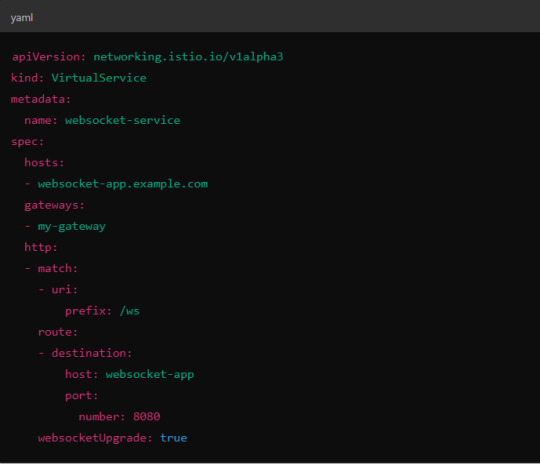
Here, websocketUpgrade: true explicitly allows WebSocket traffic and ensures that Istio won’t downgrade the WebSocket connection to HTTP.
2. Session Affinity (Sticky Sessions)
In WebSocket applications, sticky sessions or session affinity is often necessary to keep long-running WebSocket connections tied to the same backend pod. Without session affinity, WebSocket connections can be terminated if the load balancer routes the traffic to a different pod.
Implementing Session Affinity in Istio.
Session affinity is typically achieved by setting the sessionAffinity field to ClientIP at the Kubernetes service level.
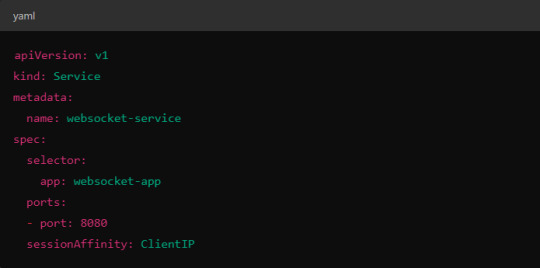
In Istio, you might also control affinity using headers. For example, Istio can route traffic based on headers by configuring a VirtualService to ensure connections stay on the same backend.
3. Load Balancing Strategy
Since WebSocket connections are long-lived, round-robin or random load balancing strategies can lead to unbalanced workloads across pods. To address this, you may consider using least connection or consistent hashing algorithms to ensure that existing connections are efficiently distributed.
Load Balancer Configuration in Istio.
Istio allows you to specify different load balancing strategies in the DestinationRule for your services. For WebSockets, the LEAST_CONN strategy may be more appropriate.
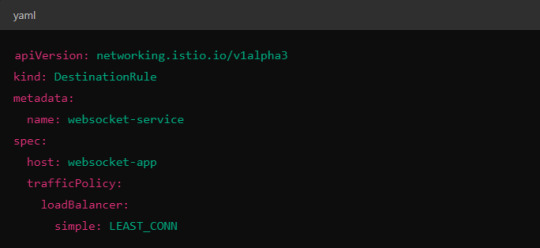
Alternatively, you could use consistent hashing for a more sticky routing based on connection properties like the user session ID.
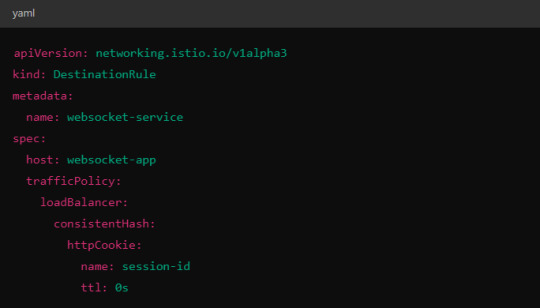
This configuration ensures that connections with the same session ID go to the same pod.
4. Scaling Considerations
WebSocket applications can handle a large number of concurrent connections, so you’ll need to ensure that your Kubernetes cluster can scale appropriately.
Horizontal Pod Autoscaler (HPA): Use an HPA to automatically scale your pods based on metrics like CPU, memory, or custom metrics such as open WebSocket connections.
Istio Autoscaler: You may also scale Istio itself to handle the increased load on the control plane as WebSocket connections increase.
5. Connection Timeouts and Keep-Alive
Ensure that both your WebSocket clients and the Istio proxy (Envoy) are configured for long-lived connections. Some settings that need attention:
Timeouts: In VirtualService, make sure there are no aggressive timeout settings that would prematurely close WebSocket connections.

Keep-Alive Settings: You can also adjust the keep-alive settings at the Envoy level if necessary. Envoy, the proxy used by Istio, supports long-lived WebSocket connections out-of-the-box, but custom keep-alive policies can be configured.
6. Ingress Gateway Configuration
If you're using an Istio Ingress Gateway, ensure that it is configured to handle WebSocket traffic. The gateway should allow for WebSocket connections on the relevant port.
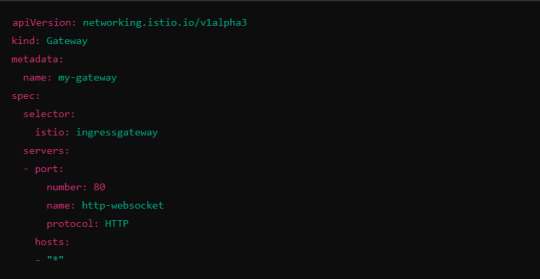
This configuration ensures that the Ingress Gateway can handle WebSocket upgrades and correctly route them to the backend service.
Summary of Key Steps
Enable WebSocket support in Istio’s VirtualService.
Use session affinity to tie WebSocket connections to the same backend pod.
Choose an appropriate load balancing strategy, such as least connection or consistent hashing.
Set timeouts and keep-alive policies to ensure long-lived WebSocket connections.
Configure the Ingress Gateway to handle WebSocket traffic.
By properly configuring Istio, Kubernetes, and your WebSocket service, you can efficiently load balance WebSocket connections in a microservices architecture.
#kubernetes#websockets#Load Balancing#devops#linux#coding#programming#Istio#virtualservices#Load Balancer#Kubernetes cluster#gateway#python#devlog#github#ansible
5 notes
·
View notes
Text
Expectations vs. Reality—Scalability vs. Elasticity in Cloud Computing

The concept of scalability vs. elasticity in cloud computing often gets mixed, but the reality hits different! In software product engineering service, both scalability and elasticity are needed.
In any system design, both scalability and elasticity hold a distinct significance. It helps businesses to keep their system intact with the latest features, capabilities, and resources. However, deciding on the right steps is still a basic software product development need. We'll eventually talk about the comparison between scalability vs. elasticity in cloud computing in detail in this blog.
What is Cloud Computing in a System?
Its foundation relies on on-demand delivery of servers, data storage, and systems over the internet for users to access them without owning them. underneath the infrastructure.
Cloud computing is the talk of the time, and capability and elasticity serve as top database solutions for handling high traffic. By knowing the static differences between the system scalability and system elasticity, you can make smarter business decisions about its utilization.
Let's get a quick introduction before diving further into scalability vs. elasticity as a software product engineering service—
CTA 1:
Make your Legacy system more scalable!
Get top database solutions for handling high traffic by Acquaint Softtech! You can consult with the best experts and get relevant business insights to help with your software product development project every now and then!
Let us know!
System Scalability: An Overview
Scalability within a system refers to a system's core capability to handle increased workloads by optimal resource utilization and without compromising its functional perspectives.
System scalability is more of a long-term strategy; taking the right steps ensures steady business growth. It's one of the two buzzwords in the world of cloud computing, the second being elasticity. People usually expect more from either of these two to be working similarly, but it is to understand for the businesses that these are two different things to get done!
System Elasticity: A Review
In contrast to system scalability, elasticity is something on a different level. Its foundational concept relies on the system's ability to dynamically adjust and manage its resource allocations based on workload fluctuations.
However, system elasticity is a short-term solution for effortless system management. In comparison to system scalability, elasticity serves to very different purposes. By implementing the right elasticity and network optimization strategies for scalable applications, businesses can explore cost-effective system elasticity and adaptability in modern IT infrastructure.
Scalability Vs. Elasticity In Cloud Computing: Expectations & Reality
The expectations and reality differences of scalability and elasticity within a software product engineering service hold their own practical implementations. Here's a detailed breakdown of anticipating and leveraging these two features within a system—
#1: Expectation: “Scalability and Elasticity Are Similar”
Reality:
It's a half-truth that system scalability and elasticity are safe. The reality is that they are closely identical in terms of business implementations. So, being closely related doesn't mean they're identical on every stage and level of the work process.
Scalability within a system is its ability to grow by the addition of more resources. It is about making your business grow eventually with time.
Elasticity is about managing the resource dynamics in real-time based on the system requirements. It's about handling multiple traffic spikes frequently in a shorter time duration.
#2: Expectation: "Scalability alone can handle resources without performance degradation."
Reality:
It's not just about system scalability when it comes to business growth. It's a long-term process that requires many cost-effective measures to operate constantly. If a business will be more predictable, you can make better plans to align with your business goals. Proper scalability requires pre-planning for resource allocation and infrastructure design.
Implementing best practices for a scalable system architecture, like vertical/horizontal scaling, will help you out in such cases. If not done proficiently, it can lead to cost overruns, ultimately making an inefficient system.
#3: Expectation: "Elasticity can achieve fully automated scaling without any workload challenges."
Reality:
Elasticity serves as a top database solution for handling high traffic, but it comes with its automation challenges. For example, if accurate monitoring techniques will not be involved, then elasticity may not be able to potentially optimize complex workloads. It needs cost-efficient auto-scaling rules and regulations to minimize your budget.
Frequent scaling events within a system lead to unexpected bills and cost volatility. Even if you're adopting high-defining techniques like resource provisioning, it may lead to latency, further leading to performance bottlenecks.
#4: Expectation: “Scalability can work automatically as soon as businesses adopt cloud computing.”
Reality:
It's not over when you adopt the cloud computing techniques for the system; actually, the work starts from there. Maintaining a system's scalability requires prompt planning and configuration with budget constraints in mind. Cloud computing, though, makes the scaling possible to a significant extent, but it's not fully automatic, to be honest.
Ask any expert of a reputed software product engineering company; they will tell you the reality in detail. First, you must configure the right auto-scaling guidelines according to your system and then the right scaling model. Continuous system monitoring and testing are applicable to align with the scalability needs.
If your system code and architecture are not concurrent, then even the heftiest of cloud servers aren't going to save you.
#5: Expectation: “Elasticity always saves a lot of business money.”
Reality:
Relying on elasticity will not always save you tons of money; it can go the other way with too much overconfidence!
System elasticity helps avoid data overprovisioning, but only when it's fully configured and planned. Poorly configured data causes frequent scaling, resulting in driving up the system costs. Elasticity planning must be done in a way that all the system resources could be utilized to their full extent. Reserving the resources but not utilizing them will waste your expenditure.
So, plan to couple your system elasticity with smart resource management, or else be ready to pay hefty bills on system scaling more often.
#6: Expectation: "Scaling and system elasticity can provide instant flexibility and infinite growth within the system."
Reality:
It requires much effort to maintain this expectation and make it a reality with time. Achieving great system flexibility works slowly, not instantly. It requires a robust, strategic business architecture to adhere to the latest market processes, smart business optimization, and ongoing business trends.
Both system scalability and elasticity hold a modern approach in cloud strategies, but they aren't any magic wands either, meaning proper planning is needed for sure to achieve both milestones. The key lies in building a highly adaptable system with the latest cloud computing system that embraces automation, statelessness, and modularity.
#7: Expectation: “Everything can be scaled easily.”
Reality:
It's a half-truth, as easy scaling is only limited to a few system components, initially. Other components don't scale that easily and require significant effort to perform such tasks. For example, you can scale stateless components with ease by applying horizontal scaling methods. In a microservice architecture, the services are loosely coupled, making space for many databases, caches, and file storages to scale better horizontally.
Whereas the same cannot be elastically scaled that easily, the third-party integrations can also become an issue if not controlled or managed. You must adopt the latest cloud-native system architecture to meet your users' demands eventually. hence, understanding the real capabilities of the system is important, and more important is to understand its limitations!
#8: Expectation: “Scalability is costly, and it is only for large enterprises to afford.”
Reality:
Scalability is a term introduced for small startups to eventually grow bigger with regular adaptation. They can benefit the most from continuous work on business scalability and elasticity. You just need to know the right scaling metrics, such as—
MVP and product-market fit standards
Cost-efficient system growth
Effortless system accountability planning to avoid replanning
Expert tip: The earlier the adoption, the better the scalability!
Businesses need to align their cloud strategies with the relevant system scalability and elasticity techniques. System scalability provides a more predictable business growth, whereas elasticity offers better management with work fluctuations. Based on workload patterns and the needs of the time, businesses must optimize their cloud strategies.
Scalability Vs. Elasticity In Cloud Computing: Major Differences
Concept
System Scalability
System Elasticity
Working
Adds resources to handle workloads.
Adjust resources to handle work demands.
Timing
According to increased work demands
Real-time dynamic scaling
Resource Allocation
Manually
Automatically
Response Time
Time-taking implementations
Instantaneous
Work load Management
Manually
Automated
Cost Effectiveness
Leads to over-provisioning
Enabled cost optimization
System Flexibility
Flexible but not instantaneous.
Instant and automated resource adjustments.
System Efficiency
Underutilized resources due to low demand
Optimized resource utilization
System Complexity
Simple to manage
Requires automation and monitoring
Use Cases
Best for systems with predictable patterns
Best for applications with unpredictable and highly variable workloads
CTA 2:
System scalability or elasticity—We Do Both!
Acquaint Softech is a leading software product engineering company that excels in availing top-rated affordable business solutions for your digital brand. Just let us know your requirements, and we'll blend classy system scaling techniques to create the most result-driven product!
Let's talk!
Conclusion—The Future of Scalability and Elasticity
Rethinking the future of scalability vs. elasticity in cloud computing is vital as the world progresses toward serverless resource provisioning. Automatic scaling-based platforms like AWS, Google Cloud, and Azure offer immense scaling utilities as per the resources, helping developers avoid overprovisioning. It is indeed one of the most cost-effective choices you can ever make for your business!
Understanding that both system scalability and elasticity are needed in order to maintain a legacy system well is important. Both approaches are necessary as AI and ML both are now giving tough competition in these cases. If you are keen to know more, simply contact a software professional to get much more detailed insight.
FAQs
1. What does scalability mean in cloud computing?
A system's core ability to manage increased workloads without sacrificing its functioning is called system scalability. It is required in every software product development legacy system to remain market-fit for a longer time.
2. What does system elasticity mean in cloud computing?
A system's ability to dynamically adjust the resources based on the system's demand and need is termed system elasticity. It basically allows the system to auto-scale up and down as required when demand increases or decreases, for optimizing business costs.
3. Can I use scalability and elasticity together within my legacy system?
Absolutely, you can easily implement either option's scalability vs. elasticity in a cloud computing system, or both, accordingly. You must consult a software engineering expert to learn more about the issue and how to implement both system scalability and elasticity well within the system.
4. What are the best tools for infrastructure scaling and elasticity?
There are many scalability tools for system infrastructure and elasticity. You must first know the exact system requirements and then figure out which tech stack will prove to be the best solution for your business. For example, to get the best system scalability, you can consult top experts and learn more details about load balancing and cloud storage solutions. Plus, top-rate system elasticity tools include Auto-scaling groups (AWS), and monitoring systems like CloudWatch.
#scalability#elasticity#cloud computing#cloud infrastructure#system scalability#elastic infrastructure#cloud architecture#software product engineering#infrastructure scaling#high-traffic systems#system performance#cloud optimization#serverless computing#load balancing#scaling strategies#cost-effective cloud solutions#system architecture#auto-scaling#resource provisioning
0 notes
Text
Can Round Robin which is a static load balancing algorithm be implemented in a dynamic way?
Yes, you’re correct that the Round Robin load balancing algorithm is typically considered static in its traditional implementation, where requests are evenly circularly distributed to servers without considering real-time factors like server load or response time. However, it can indeed be enhanced to incorporate dynamic behavior by considering real-time server conditions. Dynamic Round Robin…
View On WordPress
#Best Practices#Dynamic Round Robin#interview#interview questions#Interview Success Tips#Interview Tips#Java#Load Balancing#Microservices#programming#Round Robin#Senior Developer
0 notes
Text
When a website or application hosted on the cloud gains a significant amount of traffic, it becomes crucial to implement cloud load balancing. This helps to ensure that the application remains stable, efficient, and reliable even under heavy traffic loads. Without load balancing, a single server or instance may get overwhelmed and fail, leading to significant delays and possible outages for users.
Cloud load balancing is the process of distributing traffic, workloads, and client requests evenly across multiple servers, networks, or other resources in a cloud environment. This approach helps to optimize cloud usage by ensuring that each resource handles a reasonable workload, preventing overloads or underutilization of machines or servers in the cloud environment.
#cloud computing#cloud load balancing#cloud technology#technology#it consulting#tech#technology trends#business#load balancing
0 notes
Text
Imagine the artistry that goes behind a successful hauling operation. One such aspect bringing finesse and efficiency in this field is load balancing. Hauling services in Minnesota get it right to the tee. Professionals ensure a uniform distribution of weight within the vehicle, which guarantees not only better performance but also safer transit.
1 note
·
View note
Text
Distribution Feeder Automation Market Business Research, Types and Applications, Demand by 2032
Market Overview: The Distribution Feeder Automation Market refers to the market for advanced technologies and systems that automate the monitoring, control, and management of distribution feeders within an electrical distribution network. Distribution feeder automation improves the efficiency, reliability, and resiliency of power distribution by utilizing sensors, communication networks, and automation software to monitor and control power flows, fault detection, and restoration. These solutions enhance the performance of distribution feeders and enable utilities to deliver electricity more effectively.
Feeder Automation Market is projected to be worth USD 7.85 Billion by 2030, registering a CAGR of 8.2% during the forecast period (2022 - 2030)
Demand: The demand for distribution feeder automation is driven by several factors, including:
Distribution feeder automation solutions help utilities improve the reliability and resiliency of their distribution networks. By automating fault detection, isolation, and restoration, these systems minimize outage durations and enhance the overall performance of the grid, ensuring a more reliable power supply for customers.
Distribution feeder automation systems streamline operations by reducing manual interventions, optimizing power flow, and enhancing network monitoring capabilities. These solutions enable utilities to manage distribution feeders more efficiently, reduce costs, and improve the overall operational performance of their networks.
The increasing integration of renewable energy sources, such as solar and wind power, into the distribution grid presents operational challenges. Distribution feeder automation helps utilities manage the intermittent nature of renewables, optimize power flow, and ensure grid stability, facilitating the integration of clean energy sources.
Latest technological developments, key factors, and challenges in the Distribution Feeder Automation Market:
Latest Technological Developments:
Intelligent Sensors and IoT Integration: Distribution feeder automation is leveraging intelligent sensors and Internet of Things (IoT) integration to monitor real-time data from various points along the distribution feeders. These sensors provide insights into voltage levels, current flow, fault detection, and other parameters, enabling quicker fault localization and resolution.
Advanced Communication Protocols: Modern distribution feeder automation systems are adopting advanced communication protocols like for seamless data exchange between field devices and control centers. This facilitates real-time monitoring, remote control, and efficient data transmission.
Decentralized Control and Edge Computing: Distribution feeder automation systems are moving toward decentralized control and edge computing. This allows decision-making and control to occur closer to field devices, reducing latency and enhancing responsiveness.
Distributed Energy Resource (DER) Management: With the integration of distributed energy resources like solar panels, wind turbines, and energy storage systems, feeder automation systems are being developed to manage these resources effectively, ensuring grid stability and optimal energy distribution.
Advanced Analytics and AI: Distribution feeder automation is incorporating advanced analytics and artificial intelligence to analyze data from various sources. AI algorithms can predict and prevent potential faults, optimize energy flows, and enhance overall feeder performance.
Key Factors:
Reliability Enhancement: Distribution feeder automation improves the reliability of electricity distribution by enabling quicker fault detection, isolation, and restoration. This minimizes outage durations and enhances overall grid reliability.
Efficient Grid Management: Feeder automation allows utilities to manage the distribution grid more efficiently. Load balancing, voltage regulation, and fault management can be automated, leading to optimized energy delivery.
Integration of Renewable Energy: As the penetration of renewable energy sources increases, distribution feeder automation becomes crucial for managing the intermittent nature of these resources and maintaining grid stability.
Grid Resilience and Outage Management: Feeder automation systems enhance grid resilience by providing real-time data on grid conditions and faults. This facilitates faster response and restoration during outages, minimizing customer impact.
Challenges:
Interoperability: Integrating various devices and protocols into a cohesive feeder automation system can be challenging due to the need for interoperability between different vendors and technologies.
Cybersecurity: With increased connectivity and data exchange, distribution feeder automation systems face cybersecurity threats. Ensuring the security of these systems is paramount to prevent unauthorized access and data breaches.
Cost and Infrastructure: Implementing distribution feeder automation can involve significant upfront costs, including hardware, software, and training. Retrofitting existing infrastructure for automation may also pose challenges.
Complexity of Data Management: Feeder automation generates vast amounts of data that need to be effectively managed, analyzed, and acted upon. Handling this complexity can be demanding.
Change Management: Transitioning from manual to automated processes requires change management efforts to train personnel, address resistance, and ensure smooth integration.
Maintenance and Upgrades: Ensuring the proper functioning of feeder automation systems over time requires regular maintenance and potential upgrades to keep up with technology advancements.
Distribution feeder automation is at the forefront of modernizing electricity distribution networks. While it offers significant benefits in terms of reliability, efficiency, and resilience, addressing technical challenges and ensuring a smooth transition is crucial for successful implementation.
By visiting our website or contacting us directly, you can explore the availability of specific reports related to this market. These reports often require a purchase or subscription, but we provide comprehensive and in-depth information that can be valuable for businesses, investors, and individuals interested in this market.
“Remember to look for recent reports to ensure you have the most current and relevant information.”
Click Here, To Get Free Sample Report: https://stringentdatalytics.com/sample-request/distribution-automation-solutions-market/10965/
Market Segmentations:
Global Distribution Feeder Automation Market: By Company
• ABB
• Eaton
• Grid Solutions
• Schneider Electric
• Siemens
• Advanced Control Systems
• Atlantic City Electric
• CG
• G&W Electric
• Kalkitech
• Kyland Technology
• Moxa
• S&C Electric Company
• Schweitzer Engineering Laboratories (SEL)
Global Distribution Feeder Automation Market: By Type
• Fault Location
• Isolation
• Service Restoration
• Automatic Transfer Scheme
Global Distribution Feeder Automation Market: By Application
• Industrial
• Commercial
• Residential
Global Distribution Feeder Automation Market: Regional Analysis
The regional analysis of the global Distribution Feeder Automation market provides insights into the market's performance across different regions of the world. The analysis is based on recent and future trends and includes market forecast for the prediction period. The countries covered in the regional analysis of the Distribution Feeder Automation market report are as follows:
North America: The North America region includes the U.S., Canada, and Mexico. The U.S. is the largest market for Distribution Feeder Automation in this region, followed by Canada and Mexico. The market growth in this region is primarily driven by the presence of key market players and the increasing demand for the product.
Europe: The Europe region includes Germany, France, U.K., Russia, Italy, Spain, Turkey, Netherlands, Switzerland, Belgium, and Rest of Europe. Germany is the largest market for Distribution Feeder Automation in this region, followed by the U.K. and France. The market growth in this region is driven by the increasing demand for the product in the automotive and aerospace sectors.
Asia-Pacific: The Asia-Pacific region includes Singapore, Malaysia, Australia, Thailand, Indonesia, Philippines, China, Japan, India, South Korea, and Rest of Asia-Pacific. China is the largest market for Distribution Feeder Automation in this region, followed by Japan and India. The market growth in this region is driven by the increasing adoption of the product in various end-use industries, such as automotive, aerospace, and construction.
Middle East and Africa: The Middle East and Africa region includes Saudi Arabia, U.A.E, South Africa, Egypt, Israel, and Rest of Middle East and Africa. The market growth in this region is driven by the increasing demand for the product in the aerospace and defense sectors.
South America: The South America region includes Argentina, Brazil, and Rest of South America. Brazil is the largest market for Distribution Feeder Automation in this region, followed by Argentina. The market growth in this region is primarily driven by the increasing demand for the product in the automotive sector.
Click Here, To Buy Report: https://stringentdatalytics.com/purchase/distribution-feeder-automation-market/10966/?license=single
Reasons to Purchase Distribution Feeder Automation Market Report:
��Comprehensive Market Insights: Global research market reports provide a thorough and in-depth analysis of a specific market or industry. They offer valuable insights into market size, growth potential, trends, challenges, and opportunities, helping businesses make informed decisions and formulate effective strategies.
Market Analysis and Forecasts: These reports provide detailed analysis and forecasts of market trends, growth rates, and future market scenarios. They help businesses understand the current market landscape and anticipate future market developments, enabling them to plan and allocate resources accordingly.
Competitive Intelligence: Global research market reports provide a competitive landscape analysis, including information about key market players, their market share, strategies, and product portfolios. This information helps businesses understand their competitors' strengths and weaknesses, identify market gaps, and develop strategies to gain a competitive advantage.
Industry Trends and Insights: These reports offer insights into industry-specific trends, emerging technologies, and regulatory frameworks. Understanding industry dynamics and staying updated on the latest trends can help businesses identify growth opportunities and stay ahead in a competitive market.
Investment and Expansion Opportunities: Global research market reports provide information about investment opportunities, potential markets for expansion, and emerging growth areas. These reports help businesses identify untapped markets, assess the feasibility of investments, and make informed decisions regarding expansion strategies.
Risk Mitigation: Market reports provide risk assessment and mitigation strategies. By analyzing market dynamics, potential challenges, and regulatory frameworks, businesses can proactively identify risks and develop strategies to mitigate them, ensuring better risk management and decision-making.
Cost and Time Efficiency: Conducting comprehensive market research independently can be time-consuming and expensive. Purchasing a global research market report provides a cost-effective and time-efficient solution, saving businesses valuable resources while still gaining access to reliable and detailed market information.
Decision-Making Support: Global research market reports serve as decision-making tools by providing data-driven insights and analysis. Businesses can rely on these reports to support their decision-making process, validate assumptions, and evaluate the potential outcomes of different strategies.
In general, market research studies offer companies and organisations useful data that can aid in making decisions and maintaining competitiveness in their industry. They can offer a strong basis for decision-making, strategy formulation, and company planning.
About US:
Stringent Datalytics offers both custom and syndicated market research reports. Custom market research reports are tailored to a specific client's needs and requirements. These reports provide unique insights into a particular industry or market segment and can help businesses make informed decisions about their strategies and operations.
Syndicated market research reports, on the other hand, are pre-existing reports that are available for purchase by multiple clients. These reports are often produced on a regular basis, such as annually or quarterly, and cover a broad range of industries and market segments. Syndicated reports provide clients with insights into industry trends, market sizes, and competitive landscapes. By offering both custom and syndicated reports, Stringent Datalytics can provide clients with a range of market research solutions that can be customized to their specific needs
Contact US:
Stringent Datalytics
Contact No - +1 346 666 6655
Email Id - [email protected]
Web - https://stringentdatalytics.com/
#Distribution Feeder Automation#Smart Grid Technology#Intelligent Sensors#IoT Integration#Edge Computing#Advanced Analytics#AI in Grid Management#Microgrid Integration#Fault Detection#Voltage Regulation#Load Balancing#Power Distribution Optimization#Grid Resilience#Outage Management#Renewable Energy Integration#Distribution System Efficiency#Energy Management Solutions.
0 notes
Text
Firewall Friday: Defending Against DDoS Attacks - How to Keep Your Network Safe
Welcome to Firewall Friday, where we dive into the world of DDoS attacks and equip you with the knowledge to safeguard your network against these digital bullies. But don’t worry, we won’t let these troublemakers ruin our Friday vibes. Instead, we’ll tackle the topic with a humorous tone, using analogies and emojis to make it easy for even the most novice readers to understand. So, put on your…
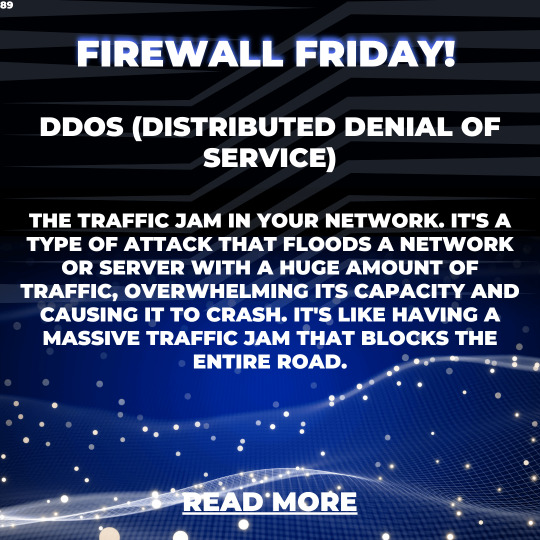
View On WordPress
#anomaly detection#cloud-based defenses#cybersecurity#DDoS attacks#firewall#intrusion prevention systems#load balancing#network security#rate limiting#traffic analysis
0 notes
Text
Seeing people say that Melinoe would be the type to reject love or love interests but like. I can see her being more polygamous than Zagreus precisely cause she's so hard-working and organized. Do you know how much work it requires to balance possibly 4 or 5 love interests? All with their own needs, personalities, vices etc.? Zagreus "my room in squalor is fine" could never.
#Melinoe#Zagreus (hades)#hades 2#hades II#hades II spoilers#yes Zagreus “god of relationship counseling” would be able to connect to many partners emotionally#but balancing all their needs? idk idk boy needs to work on that#Mel on the other hand I think could shoulder the load#especially with the stepkids that would come from Arachne's and Eris's angles
224 notes
·
View notes
Text
I want everyone to know from the bottom of my heart that if a teacher assigns you group work it's because they've talked themselves into believing it's pedagogically sound to sit at their desk for twenty minutes
31 notes
·
View notes
Text
woe silly Mia (+ Sol) doodles be upon ye














Mia... i miss her..... i need to post her more........
#Aughhh words can't describe just how badly i wanna yap about this specimen of a bimbo and her relationship with Sol........#She and Sol are timeloop buddies and to describe it best have sort of a yin and yang dynamic (within the wormhole and in general#Mia becomes the yin to Sol's yang and Sol becomes the yang to Mia's yin) and they challenge their moral beliefs and approach on handling#themselves and try to find a balance between selflessness (Sol) and selfishness (Mia)#it's nearly 4 am and i didn't explain it well since theres more to it but STILL#also get a load of Mia with her hair down my babies girl#i was a teenage exocolonist#iwatex#exocolonist#my art#art#artists on tumblr#sol exocolonist#mia exocolonist#iwatex oc#oc#my oc#my original character#original character#oc art#doodles#shitpost#anyways im going to sleep now
20 notes
·
View notes
Text
Tony: here, hold this *hands Peter a wrench*
Peter: *now holding 17 different tools* I think I'm gonna drop it
Tony: You're fine
*loud clang and crash*
Peter: ...I dropped it
#Tony just started handing him tools#peter didnt complain even when he had 6 and they were balanced precariously#so tony decided to see how many peter could hold#it was only 16#but after more extensive research and testing#peter can hold 32 screwdrivers with no notice or preparation#7 wrenches on a separate occasion#and he can hold 26 hammers#peter still doesnt know why tony keeps handing him loads of stuff#he is utterly oblivious#there are also betting pools of how many tools he can carry#bucky has won all of them so far#he is freakishly good at guessing things#peter parker#tony stark#ironman#spiderman#marvel#marvel cinematic universe#incorrect mcu quotes#incorrect mcu#marvel incorrect quotes#incorrect quotes#mcu#incorrect peter parker#incorrect tony stark#irondad#irondad and spiderson#spiderson
409 notes
·
View notes
Text
hot take rlcraft sucks its not enjoyable at all
#man its challenging without a point if that makes sense#u can load up a new world and die 20 times before u get away from spawn .... not my kind of hell ty#feels like a lot of shit was just thrown in to be hard#not fun or balanced#its good for ppl to make 2000000 yt videos out of ig but not to play
115 notes
·
View notes
Text
Having an office job is like, 60% waiting for a report to load.
#you’ll wait ten minutes for a report in oracle to finally load just to tell you that you put the wrong info so you got an error#I’ve actually been trying to generate a trial balance since yesterday but it keeps taking so long that it times out
23 notes
·
View notes
Text
What are the top load-balancing algorithms used? Where are these algorithms mostly used?
Load-balancing algorithms are essential components of distributed systems, helping distribute incoming traffic across multiple servers or resources to improve reliability, scalability, and performance. Let’s explore some of the top load-balancing algorithms, categorized as static and dynamic, along with examples of technologies that utilize them. Static Load Balancing Algorithms: Static load…
View On WordPress
#interview questions#Interview Success Tips#Interview Tips#Load Balancing#Microservices#programming#Senior Developer#Software Architects
0 notes
Text


Now then, to the mask dress. I've already picked out most of the parts, but now it's a matter of choosing which side split to work with. The red dress would be the most accurate, although I'd have to smooth out the texture to remove the sparkle. Alternatively there's going with the super tall thigh split that's off to the side, but I remember being an even bigger nightmare to work with.
#sims 3#wips3cc#wip#I'm leaning towards the red hot dress just for accuracy#but let's be honest#my indecisive ass may just choose to do them both#because what's having a healthy creator load balance?
7 notes
·
View notes
Text



#best sneaker footwear drops releases november 2024 week 4 nike adidas where to buy#Adidas#We’re rolling into the final days of November with a full head of steam#and the world’s biggest sneaker brands have one more round of drops set for us before we switch the calendar to the year’s final month. Nik#adidas#PUMA and more have everything from high-heat hoop shoes and altered takes on classics locked and loaded for this week#but before we dive in let’s take a look back at what went down over the last seven days first.#Nike had a wild week across all verticals#with two tenured collaborators#Stash and Hiroshi Fujiwara#teasing forthcoming projects (Air Max 95/Air Force 1 and Air Zoom Spiridon#respectively). Kobe Bryant got a tribute on two different Air Force 1 colorways — the “Home” and a black pair — that are set to release nex#while Travis Scott’s Jordan Jumpman Jack “Bright Cactus” had its official images revealed and several Nike/Jordan Brand sneakers debuted in#Not to be outdone#adidas made plenty of noise of their own. Olympic gold medalist Noah Lyles debuted a new Bad Bunny collab#while Jerry Lorenzo’s next Fear of God Athletics basketball shoes surfaced and the brand showed off a Foam Runner-indebted silhouette calle#with New Balance’s 993 having multiple moments in the spotlight thanks to the likes of JJJJound and Aimé Leon Dore#while OTTO 958 showed off its latest ASICS collab and stylist Veneda Carter continued her collaborative relationship with Timberland.#Now that you’re up to speed#check out what shoes are dropping this upcoming week and be sure to hit up HBX to shop styles that are available now.#Sporty & Rich x adidas SL72 “Sweden Pack”#Release Date: November 26#Release Price: $120 USD#Where to Buy: adidas#Why You Should Cop:Sporty & Rich announced its new collaboration with adidas Originals on the SL72 “Sweden Pack” last week — and it’s inspi#it’s been reworked with a retro aesthetic that pays homage to the athletic footwear designs of the 70s. adidas and S&R have used a selectio#using the colors to nod to Sweden’s national colors. Customary Three Stripe branding is applied to the lateral sides of the shoes#while further branding is applied to the tongues and heel counters to round things off.#Nike Air Max Waffle “Triple Black”#Release Price: $140 USD
11 notes
·
View notes